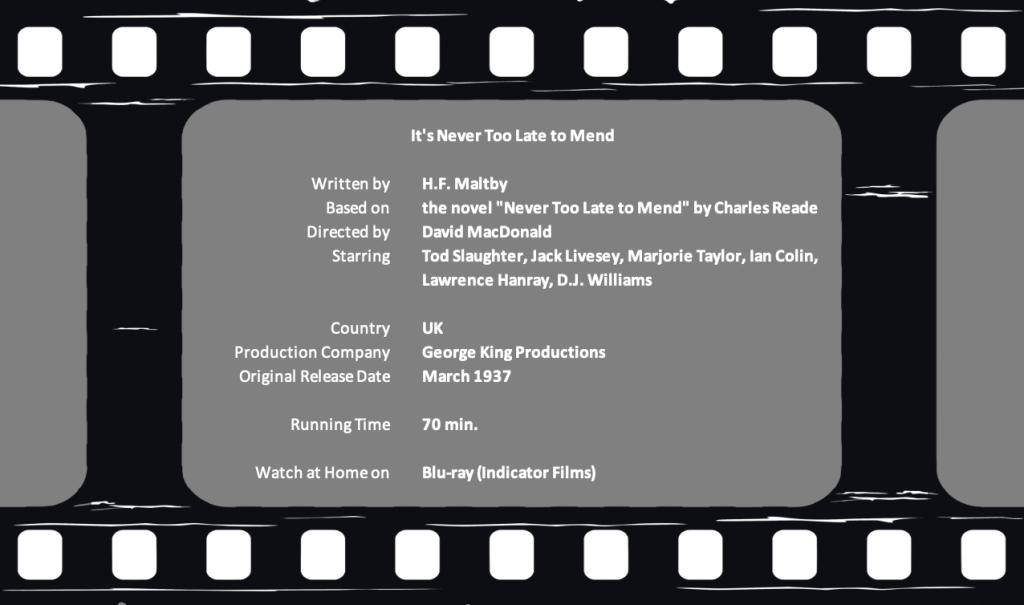
A title card before It’s Never Too Late to Mend (1937) reads, “Controlled and Presented by The Rev. Brian Hession, M.A., copyright Dawn Trust.” My puzzlement was reinforced when I learned that Hession, who was at the time a vicar, had created Dawn Trust Films to bring religious themes to mainstream cinema. So this was going to be a religious film?
Then, two title cards explain that Charles Reade wrote the book in 1856 to expose conditions in English prisons. After Queen Victoria read the book, she ordered an investigation to determine if these brutalities were indeed being performed in her name. Oh, OK, so this was going to be a prison reform film?
Then, the film proper opens with Squire John Meadows (Tod Slaughter) not quite twirling his mustache, but certainly smoothing its hairy underbelly with his index finger. He’s immediately plotting to get rid of George Fielding (Ian Colin) so he can have his woman, Susan Merton (Marjorie Taylor.) OK, this was going to be a… wait a minute, what the heck kind of movie is this?!?
Ultimately, and unfortunately, I found it to be the silly kind of movie. Three disparate plot elements do actually come together in a compelling way: Squire Meadows frames Fielding to get him sent to prison where we and the Rev. Mr. Eden (Roy Russell) witness its cruelties, Squire Meadows being one of the biggest perpetrators.
Now that I recall, it’s not Fielding who goes to prison. It’s Tom Robinson (Jack Lively) who takes responsibility for a crime so that his buddy can go about living his life, travel to Australia, strike it rich, and return home with a huge dowry for Susan.
However, the melodrama that comes from Slaughter’s past and runs through all his films (that I’ve seen so far) is turned up to 11 by the end and I didn’t know whether to laugh or cry. The straw that broke this camel’s back was when Squire Meadows donned a black cape and hat and lurked outside the door spying on other characters.
My back was near its breaking point a bit earlier when, just as Fielding returned to town and was chatting with the just-released Robinson, Squire Meadows slowly leans his face into the shot on the other side of the window looking inside. I can’t begin to explain how sad and comical I found this.
The music doesn’t help. All that’s missing is a woman bound on the tracks as a train speeds toward her, Squire Meadows laughing maniacally nearby. Perhaps what’s bothering me most about this delivery is that it’s not consistent. The movie starts out serious with some interesting intersecting points, then suddenly devolves.
Finally, the villain ends his wrath similar to how he did previously in The Crimes of Stephen Hawk, and will soon do again in The Ticket of Leave Man. Rather than run or try to talk his way out of the situation, he goes nuts, grabbing a gun (usually with only one bullet… and how does he know that, by the way?) and threatening his potential captors.
You can guess how the tables are turned on Squire Meadows and SPOILER! he ends up being one of the prisoners experiencing the torture he inflicted on so many others. Will he turn over a new leaf? We’re reminded, probably by Rev. Brian Hession, that it’s never too late to mend. For me, it’s never too late to eject a Blu-ray, but in this case, sadly, it was.


Leave a comment